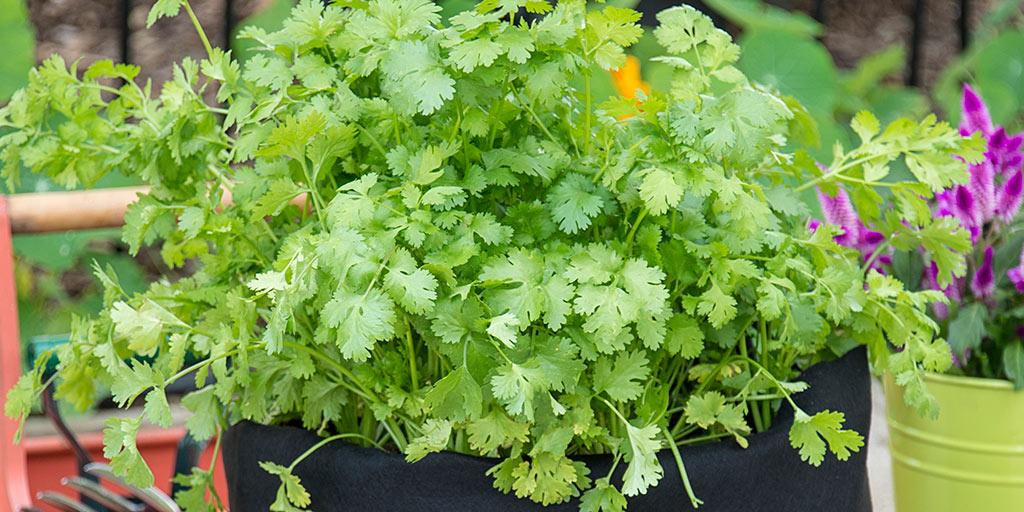Beth Sears has worked in the garden industry for 10 years—and grows fruits, vegetables and flowers in her Midwest garden.
Cilantro is one of the easiest herbs to grow—and, if you are a cilantro lover, it’s a must-have for flavoring salsa as well as many Asian, Mexican, Indian and other recipes. While this complexly flavored, pungent herb can be dried, it’s most flavorful and best when eaten fresh. That’s why many gourmets and gardeners grow their own.
Cilantro can be grown indoors or in the garden. It’s a short-lived herb that goes to seed (producing coriander) and easily reseeds itself. However, with a little planning, you can grow and harvest your own fresh cilantro for months.
Cilantro vs. Coriander
A common question is what’s the difference between cilantro and coriander? Cilantro and coriander come from the same plant, Coriandrum sativum. The leaves from the plant are called cilantro. When the plant goes to seed, the seeds are harvested and called coriander. In North America, you’ll usually find the seeds and plants listed as cilantro. In other parts of the world, they may be listed as coriander.
How to Plant Cilantro Seeds or Starter Plants
You can grow cilantro from seeds, plants or cuttings. Because seeds are inexpensive and cilantro is so easy to grow from seed, it’s the most common way to grow cilantro. The other benefit of growing cilantro from seed is that you can harvest them at the baby green or microgreen stage. You can grow cilantro from cuttings, but need to have access to a cilantro plant. While plants are more expensive, it’s a quick way to start growing cilantro.
When growing cilantro, keep in mind that it grows quickly, flowers and goes to seed. If the seed heads are left on the plant, some will drop to the ground, germinate and grow into more cilantro plants.
Starting Cilantro from Seed
If growing in the garden, sow cilantro seeds about 1/4 in. deep after the danger of spring frost has passed. Space the seeds about 1-2 in. apart. Water well. Cilantro seeds usually germinate about 7-10 days after sowing. When plants emerge, thin the seedlings so they are about 6 in. apart. Because cilantro grows so quickly, you can begin harvesting leaves about 40-45 days after sowing. To ensure a continual harvest of cilantro, sow seeds about every 3 weeks until early summer. Seeds can be planted in late summer for a fall harvest.
Planting Cilantro Plants
If starting with a cilantro plant, keep in mind that cilantro has a long tap root that must be handled with care. Plants growing in peat pots are often the easiest to plant because you don’t have to disturb the tap root. Wait to plant your cilantro plant until all danger of spring frost has passed. When planting, dig a hole large enough to accommodate the root ball.
Growing Cilantro Outdoors
Cilantro grows best in cool, dry climates. In northern areas, it can handle direct afternoon sun. In southern climates, it does best with some shade in the afternoon. In hot climates, the plants tend to bolt quickly.
Cilantro grows best in well-drained soil. Mixing compost into the soil can enhance the soil structure, improve drainage and provide it with organic matter. When growing cilantro outdoors, some gardeners grow it in a garden corner where it can happily reseed itself throughout the growing season.
Cilantro has average water needs, or requires about an inch of rainfall weekly. If watering, water at the base of the plant or use an irrigation system to avoid overhead watering. Cilantro plants don’t like to sit in soggy soil.
How to Grow Cilantro Indoors
Cilantro can be grown indoors—and it’s a joy to snip some fresh leaves for your favorite recipes. Because indoor temperatures are usually cooler than hot summer temperatures, cilantro plants grown indoors don’t bolt as quickly. Growing cilantro indoors, though, can be more challenging than growing it outdoors in the garden. However, with a little planning, you can enjoy fresh cilantro from indoor plants. Here’s how you grow cilantro in a pot indoors.
When growing cilantro indoors, it requires 5-6 hours of direct sunlight daily. You can also use a grow light to ensure it gets enough light.
Growing cilantro indoors requires the right pot or container. Gardeners have had success with terra cotta pots, glazed clay and plastic pots. Note that the soil tends to dry more quickly in terra cotta pots. If growing one plant, then an 8-in. pot is suitable. If growing three plants, choose a 12-in. pot. Whatever container you use must have drainage holes. Cilantro does not like to sit in soggy soil.
When growing cilantro indoors, use a quality potting soil that allows for good drainage. You’ll have to water more frequently than you do for cilantro growing in the garden. When watering, wait until the soil dries on the top. Then water thoroughly so that water comes out of the drainage holes.
Because cilantro has a long tap root, it doesn’t absorb nutrients as well when potted as it does in the garden. Fertilize cilantro plants growing indoors. A liquid fish emulsion is often used.
When growing cilantro indoors, you can either sow cilantro seeds or buy plants. Some people also grow microgreens indoors. If sowing seeds, the soil temperature needs to be 55-70 degrees for optimal germination.
Tips for Healthy Cilantro Care
Cilantro has a short life cycle and tends to flower and develop seedpods when the temperatures heat up. To maximize the foliage, pinch back the young cilantro plants. This also makes the plants’ bushier. You can also maximize leaf production by cutting off the top of the main stem as soon as flower buds start to appear. During hot weather, though, the plants will bolt and stop producing foliage.
Insects and Diseases That Can Harm Cilantro Plants
Cilantro plants have few disease and insect problems. Providing them with plenty of air circulation and avoiding overhead watering helps control diseases such as leaf spot and powdery mildew. Cilantro doesn’t like humid conditions and excess moisture.
Inspect your plants for signs of damage from aphids, leaf hoppers or other insects. If using garden insect controls, use an insecticidal soap or other product that is safe for edible plants. Read all label instructions before use.
How to Harvest and Store Cilantro
You can harvest cilantro when the plants are 6 in. tall. Harvest the upper, finely cut leaves on the plant, rather than the coarser leaves near the plant’s bottom. You can also harvest the entire plant. Cilantro is best used fresh, and unlike some herbs, does not dry well. The leaves tend to lose quite a bit of flavor. Once harvested, cilantro leaves keep for up to a week in the refrigerator.
Because cilantro plants grown indoors often don’t tend to grow as quickly as cilantro grown outdoors, harvest sparingly. Pinch off some leaves near the top of the plant.
If harvesting seeds for coriander, cut the stems with the seed pods from the plant. Place the seed pods in a paper bag and store in a cool, dry place where the seeds can continue drying. Shake or roll the dried pods to release the seeds.
Because it’s best for eating fresh and so easy to grow from seed, cilantro is one of the most rewarding herbs to grow in the home garden. If growing cilantro, here are some of the most important things to know:
- Its tap root makes it difficult to transplant.
- It grows quickly and goes to seed quickly. Because of this, planting cilantro seed every 3 weeks keeps the harvest coming.
- It’s a cool-season plant and doesn’t care for hot temperatures. In the heat of the summer, it bolts quickly.
- After cilantro goes to seed, the seeds can be collected and dried (coriander seeds). If the seeds fall to the ground, they will likely germinate and grow into more cilantro plants.
- While it can be grown indoors, special care is required to do this.
- Cilantro adds flavor to salsas and flavoring many Asian, Mexican, Indian and other recipes.
If you’re new to growing herbs, cilantro is one of the most rewarding ones to try—and it’ll liven up your salsas and other recipes!
FAQs
- Does cilantro need full sun? In most cases, you can grow cilantro in partial shade. In northern climates where temperatures are cooler, it performs well in full sun.
- How do you grow cilantro from cuttings?
Cut a 4-in. stem from a healthy cilantro plant. Take the cutting below a node. Remove the leaves from the bottom half of the stem and place it in a jar of water. When it generates roots, plant it in potting soil. - How long does it take to grow cilantro?
You can begin lightly harvesting cilantro plants about 40-45 days after sowing seed - Is cilantro easy to grow?
Cilantro is one of the easiest herbs to grow from seed, especially outdoors in the garden. Because of its taproot, transplanting it and growing it indoors presents some challenges.

